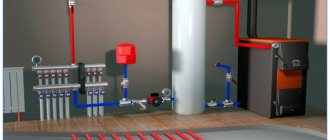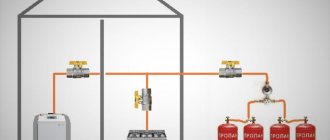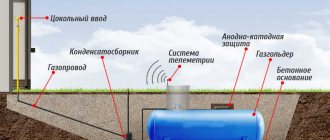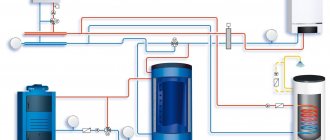A gas holder is a container or barrel for storing liquefied petroleum gas (LPG), consisting of propane and butane. Installed when installing an autonomous heating system in country houses, private houses, gasification of industrial enterprises, where connecting to the central gas pipeline is impossible or too expensive. With the required tank volume, one LPG refill should be enough for the heating season.
Let's analyze all the possible nuances of such autonomous gasification.
Where is the gas tank used?
A gas tank is used for long-term storage of liquefied gas and flammable substances. Its main purpose is to store LPG to ensure autonomous gas supply to the following facilities:
- country houses, cottages, dachas in the private sector;
- industrial enterprises;
- industrial buildings;
- buildings for seasonal use (recreation centers).
Most often, installation of a gas tank is practiced in villages and small towns that are located at a great distance from the main gas pipeline.
This is much more profitable than connecting to central engineering systems.
Nuances of choice
Having decided in favor of LPG heating, you can easily get lost in the variety of models on the market. To understand which equipment is optimal in your case, you need to answer two questions.
- Will only heating be connected to the system, or will there also be hot water supply?
- Will you need year-round full heating, or just maintaining heat (for example, in a country house)?
By answering these questions, you will significantly narrow down your options. And of course, you can always consult with our specialists by ordering a call on the website. We will tell you how to choose a gas tank in your case and what to look for when purchasing.
What types are there?
Depending on the volume of the container and installation method, devices are divided into several types. Let us examine in more detail the features and differences of each of the installations.
Mobile
Mobile gas holder is a small-sized mobile unit. Convenient for households that are used seasonally, such as dachas. During winter, they can be stored until next summer. You don't need a lot of space to place it on the site. You don't have to rent special equipment to connect it. The tank volume is on average from 500 to 600 liters. Cheaper than any landline. Although the installation is small, it is prohibited to use it without obtaining permission from the gas service, as well as to try to connect it yourself.
The tank is equipped with an automatic safety system that monitors the level of gas supply to the house and, in the event of an emergency, will stop the supply.
Vertical
A vertical gas holder is suitable for a small private building. Its volume is enough to ensure constant availability of hot water and cooking during the summer season.
Takes up little space. It looks like a metal can.
It is permissible to place it on site even if gas consumption is high, by selecting a container of the appropriate size, but in this case the tank is equipped with special evaporators, which are responsible for maintaining the operating pressure during the supply and distribution of gas. In addition, large vertical tanks for the private sector are designed for underground installation, and this increases the cost of work several times.
Vertical tanks are also used on an industrial scale. For example, RVS-1000 is used for storing large volumes of water and petroleum products.
Horizontal
The stationary horizontal gas holder is considered the most popular among private sector owners due to the large area of the liquid phase.
This means that in a horizontal container, the volume of the air-gas mixture provides operating pressure even under conditions of increased consumption. The required level of evaporation is achieved naturally without installing additional devices. That is, a horizontal gas installation will be cheaper than others and will work with the required level of pressure even in severe frosts.
The only negative is that it will take a lot of space on the plot to dig a pit for such a container.
Ground
Already from the name it is clear that the tank is installed on the surface of the earth. For private use it is better because:
- easier to maintain;
- it is easier to detect breakdowns and traces of corrosion;
- conveniently control the operation of equipment;
- It’s easier to pump gas into the tank.
But there are two significant drawbacks: in winter, the ability to evaporate decreases, and it will be necessary to ensure that all safety measures are taken when installing a gas storage facility.
The tank should not be exposed to direct sunlight. Although the body of the barrel is considered resistant to high temperatures, it is better to place the container in the shade.
For a summer residence, it is more convenient to install a ground-based vertical tank; for year-round heating of the house and cooking - a horizontal one or several vertical ones connected into one network.
On an industrial scale, ground-based gas tank stations are used at classical-type gas filling stations.
The advantage of the installation is the absence of excavation work
.
Disadvantage: a large area is required for placement. The operating temperature range is from -40 degrees to +40 degrees.
Underground
It is recommended to install underground gas tanks in northern regions with harsh and frosty winters, since the underground tank will be protected from the cold and the operating pressure will be maintained.
From a safety point of view, underground placement is much more reliable.
The minimum installation depth is from 60 cm. In this case, regardless of the volume of the gas storage tank, only the neck with the lid will be visible from above. The remaining part of the body is covered with earth and you can walk on it or plant flowers there. The landscape of the site does not deteriorate and looks neat and beautiful. A filling unit is connected to the neck, and gas flows into the house through pipes.
Service life reaches 50 years.
The disadvantage of an underground gas tank is the large volume of excavation work and the rental of special equipment, which entails additional costs.
At gas filling stations, underground structures serve as propane-butane storage facilities. placed below the soil freezing level. The surface of the tank is covered with special corrosion protection. Above ground level, a neck with gas fittings, valves, a pressure gauge and other elements will be visible.
Vertical or horizontal
Gas tanks that are installed vertically are of more interest to owners of small plots: this way they can comply with all placement requirements and save precious space. This is the most important advantage of vertical gas holders, and for this reason they are so popular in European countries.
In our country of large territories and high groundwater levels, the horizontal option is more common.
Andrey2 Member of FORUMHOUSE
It is cheaper to bury a horizontal one, but if the groundwater level is high, then the vertical one is more difficult to install.
About the fact that “vertical gas tanks have a small evaporation mirror, and with a large analysis there may be a lack of gas fraction” - on the portal there are quite a few owners of vertical tanks who did not feel any inconvenience at all from the small evaporation mirror.
Which gas holder to choose: with high pipes or a high neck
Depending on the conditions for autonomous gasification, two types of gas holders are used.
With high pipes
Placed on estates with a high groundwater level, on clay or loamy soil. The pipes located above the ground surface, on which the pressure regulator and shut-off valves are installed, make it possible to prevent flooding and water from entering the equipment, and provide convenient access to monitoring and filling the tank if necessary.
High neck
A gas holder with a high neck is suitable for gasification of industrial facilities and buildings where it is necessary to ensure an increased level of safety. Used on marshy soils or with a high probability of flooding.
In any weather conditions, precipitation or water will not reach the gas tank fittings. There is convenient access to the tank at any time. The wide hatch-groove simplifies the re-inspection of the container for safety of use every 20 years. A powerful boiler can be connected to such a gas holder.
Video description
For more information about the gas tank and its installation, watch the video:
To control and regulate the process, the system has special automation; if you need to shut off the supply, you just need to turn a special tap. Excess pressure is removed using a special valve. The remaining gas is recorded thanks to a warning system that will warn the owner about the need to refill the tank.
Gas tank automation Source m.mitex-shop.ru
Pros and cons of an autonomous gas holder for the home
Among the advantages of using a gas holder in private gas supply, the following are worth highlighting:
- Independence from the main gas pipeline.
- Liquefied propane-butane has greater efficiency than conventional natural gas.
- When connecting a gas generator, the gas holder can also serve as a reliable source of electricity.
- Problems with pressure drop, as is often observed with centralized gas supply, are eliminated.
- When burned, propane-butane does not form gas, and much less harmful substances are released.
- When leaking, LPG evaporates and does not get into the soil.
- Owners can start and end the heating season whenever they see fit.
One of the disadvantages of an autonomous gas supply is that the price of equipment and installation averages from 500,000 rubles (excluding the cost of the boiler and generator), and you need to pump fuel 1 or 2 times a year.
Profit or ruin
How profitable is a gas tank, does it pay for itself, and when does it make sense to install it in a country house or country house, and when not? This issue has been discussed on FORUMHOUSE for many years. There is no universal answer here, each case is individual, it all depends on the size and quality of insulation of the house, the climate of the region, and the prices of other types of fuel.
But here are the things we managed to agree on:
- Gas tank heating will be more profitable if you fill the tank once a year, in May. The cost of fuel in May is 20% lower than in October. But for this, the tank must have a sufficiently large volume.
- Gas holder heating is definitely cheaper than diesel heating, and in a number of regions of our country in terms of return on investment it ranks second after natural gas;
Westpoint FORUMHOUSE Member
Barrels with a volume of 4850 for a house of 130 sq.m. Should be enough for a year with a one-time refill. This is half of what I spend on pellets now.
- If the area of the house is more than 100 square meters, an autonomous gas heating system based on a gas holder may already be appropriate. If you just need to heat a small dacha, it would be better to go with electricity.
spbplumbing FORUMHOUSE Member
It all depends on capital investments, but a gas holder will be cheaper than a diesel boiler with piping, a chimney, a container, and installation.
KhrunchaModerator FORUMHOUSE
Personally, I don’t regret at all [that I buried the gas holder]. Ownership experience 8 years.
Even those people who loudly regret having installed gas tanks do not want to sell them.
Here are some reviews of how much it cost to heat a home with LPG for users of our portal last year, 2022.
MblParticipant FORUMHOUSE, Moscow.
The total area is 150 square meters + sauna 70. Of these, I constantly heat 60-70 m to + 21 degrees, in the sauna I maintain +5 all week, and +21 on weekends. Consumption per year under this regime is 40,000-45,000 rubles. There are about 2500 liters. I have a barrel with a volume of 4850 liters.
A member of our portal with the nickname IlyaKu has been operating a 6400 liter gas tank for four years. The area of his house is 10 square meters, and he chose such a large tank, planning to subsequently connect his relatives’ house to it. Both houses are permanent residences, without heated floors, with radiators.
IlyaKuForumHouse Member
While there was one house of 160 m2, there was enough fuel for the whole year and with a huge supply, the supply allowed you to choose when it was more profitable to refuel (minimum price May-June, maximum October-December).
After connecting the second house, a house with an area of 140 m2 has to be refueled twice a year, in total for two houses in 2022 it came out to 119,000 rubles, in the past 129,000.
FORUMHOUSE members who live close to each other find partners on the forum to refuel together. Judging by the reviews, this allows you to save from 50 kopecks to a ruble for each liter - it is much more profitable for gas stations to carry full tanks.
But this is about fuel consumption; Many people are more afraid of the cost of installing equipment. They are indeed considerable, but – and this can be looked at from different angles.
ChaleFORUMHOUSE Member
Believe me, compared to the cost of a house with some furniture and appliances, 350 thousand for everything including the first gas station will seem like a small amount.
Design and principle of operation of an autonomous gas tank
If gas is needed only for the uninterrupted operation of the stove, then one or two gas cylinders of standard capacity will be enough. To heat the house, cook food and generate electricity through a gas generator, you will need to install a tank with a capacity of 2000 to 20,000 liters. The volume is calculated individually according to the needs of the owners.
The operation of an autonomous gas tank consists of the following points:
- A tank is placed near the house. According to safety precautions, the required distance should be 10 m. The distance from the water intake is 15 m. Do not forget about the convenience of access by a tanker truck to refill the gas tank.
- The pit for the tank must be below the soil freezing level. In this case, there will be no risk of LPG freezing in severe frost.
- If necessary, a monolithic slab can be poured under the tank.
- The container is filled with LPG - natural gas, cooled and liquefied under low temperature. Thus, the gas mixture decreases in volume by approximately 600 times. The concentration of sulfur compounds is also reduced. The gas evaporates. Then the gas passes through the reducer, where the operating pressure is 30–50 millibars.
- Gas with this pressure is supplied from the neck of the gas tank into the pipeline. In this case, proper pipe routing must be provided for the boiler, supply to the kitchen for the gas stove, and to the generator.
To ensure an effective evaporation process, you need to take into account the following nuances:
- The container must be supplied with propane-butane no more than 85%.
- The container should not be allowed to cool to a temperature below 0 degrees. In most cases, this applies to ground-based gas tanks. Therefore, it is necessary to provide for insulation of the structure.
- Vertical tanks have a small evaporation area, which means that additional evaporators will have to be installed.
This gas supply technology implies that the tank is not completely filled with the gas mixture, due to which the LPG gradually turns into a gaseous state and is supplied into the pipes under high pressure.
Safety precautions
A gas holder is no more dangerous than a gas cylinder. But this equipment requires increased responsibility of the owner. To do this, you need to regularly inspect the equipment to prevent corrosion, and invite specialists to carry out maintenance at least once every 2 years.
The device is equipped with a valve to relieve excess pressure. Gas leakage monitoring is carried out by devices located in the house. They block the flow of gas from the tank in the event of a fire or flood.
For safety reasons, you should not use containers that have expired or have been used.
How to correctly calculate the required volume of a gas tank
Such a characteristic as volume requires precise calculations. This takes into account:
- power and other operating properties of the boiler;
- total area of the house;
- characteristics and frequency of use of the stove;
- whether the gas generator will be connected or not.
It is recommended to purchase horizontal gas tanks with a margin of 15%; for vertical gas tanks, a margin of 10% is enough.
A properly calculated tank volume will allow you to avoid unnecessary costs and overpayments, and will allow you to accurately determine the amount of gas that needs to be refilled. One refill should be enough for the heating season.
When making calculations, it is recommended to use the formula where the average consumption of the gas mixture (approximately 20 liters per 1 sq. m per season) is multiplied by the area of the house. It should be remembered that gas consumption in summer is several times less.
That is, it works for a private house with a total area of up to 100 square meters. m, a gas tank of 4850 liters (5 cubic meters) will be sufficient for an area of 200 sq. m. m – volume 6400 l. For large cottages with an area of 300 sq.m. m will require a volume of 9200 liters.
Let’s summarize using an example of a real situation: the boiler turned off
- Check the pressure gauge in front of the equipment. If the pressure is normal (from 37 mbar), the cause is a boiler failure. We need to call repairmen. If there is no pressure, we move along the chain to the next point.
- Check the pressure after the reducer (if there is a pressure gauge). If everything is in order here, then the gas pipeline is clogged: the condensate collector is full, a plug has formed, and the condensate in the basement inlet has frozen. Call specialists for cleaning and purging.
- If there is no pressure gauge or the needle is at zero, look at the pressure gauge in front of the regulator. There must be at least 1.5 bar here, otherwise the gearbox will not work. Is your blood pressure normal? This means the problem is in the gearbox - most likely frozen. Call specialists to turn off the gas, remove, warm up and blow out the regulator.
- If there is not enough pressure on the main pressure gauge, but the level gauge shows more than 15%, then most likely, buttanning has occurred. Most of the propane is used up, and butane cannot provide the required pressure in cold weather. Order delivery of a winter mixture with a high propane content.
- If the level gauge needle approaches 20–25%, it’s time to call a gas carrier. Less than 15% of the liquid phase cannot be left.
Result: After checking the main points, you find the cause of the outages and take the necessary measures. In three cases, the intervention of maintenance specialists will be required, in the rest - calling a tanker truck with LPG.
During normal use, monitor the level of the liquid phase when filling - no more than 85%. And call the gas carrier when the LPG level drops to 20–25%.
Check the pressure gauges at the same time. Such monitoring will be enough to detect a malfunction in time. The remaining units are inspected by technicians during regular maintenance.
Manufacturers recommend checking the operation of the system annually. And once every 8 years, call specialists for deeper control to assess the coating, seams and general condition of the gas tank.
How it works for us
When installing a gas tank, we sign a contract for a year of free service. List of services: 2 preventive visits by a specialist (in winter and autumn) + one urgent emergency call within 24 hours. Then the service contract can be extended.
Is it profitable to install a gas tank?
Autonomous gasification using a gas holder is more profitable compared to connecting to the main gas pipeline or using bottled gas.
The benefits, in contrast to using gas supply through a centralized network, are as follows:
- Autonomy of the heating system. There is no need to worry that the gas may be turned off due to an accident or repair work on the main pipeline.
- Independence from centralized power supply. With a connected gas generator, you can ensure an autonomous supply of electricity to the entire house at all times.
- There is no way to connect to the main line or the pipes need to be laid at too great a distance. Installing a gas tank will cost several times less.
- Gas supply failures are eliminated.
- Accurate individual calculations for specific volumes of gas consumption.
The only caveat is that you need to pump the mixture into the tank in a timely manner.
In comparison with bottled gas supply, the benefits are as follows:
- Provision of gas for cooking purposes only. Not suitable for year-round gas supply.
- Frequent gas refills are required, which incurs shipping costs, especially when there are no gas stations nearby.
- In winter, the mixture in the cylinders only partially evaporates, which entails losses.
- Self-installation and use of used cylinders often leads to emergency situations that are dangerous to the life and health of residents.
The benefits of installing a gas tank are obvious - ease of use, uninterrupted gas supply all year round, safety and cost-effectiveness of the equipment.
Negative aspects of autonomous gasification for a country house or dacha
Among the disadvantages of autonomous gasification is the high cost of equipment and its installation. However, these are one-time costs that will be recouped in the future through the use of cheaper fuel.
In addition, the disadvantages of such a gas supply system include the need for constant monitoring of the serviceability of the equipment and the absence of corrosion.
Every 2 years a technician is called in to inspect and check the system. This increases financial costs.
Safety measures during installation and operation of gas equipment
All work processes must be carried out in strict accordance with fire safety regulations. The following standards govern installation work:
- Federal Law No. 123-FZ;
- GOST 5172-63;
- SP 62.13330.2011, section 8;
- SP 43.13330.2012, paragraph 6.2;
- GOST 20448-2018.
Key requirements for tank installation:
- The distance from a residential building for underground placement is 10 m, for above-ground placement is 20 m.
- Distance from utility networks and other buildings on the site is 2 m.
- When installing above ground, you should consider thermal insulation of the container so that the propane-butane inside it does not freeze in the winter.
- Sunlight exposure to the tank should be minimal.
- The average depth and width of the pit for the container is 2 m. The length is determined individually - depending on the size of the tank.
- The bottom of the pit should be covered with a layer of sand cushion or a monolithic slab should be poured for ease of fixing the tank with cables and bolts.
- The gas holder fixed in the pit must be filled with sand. It will not retain water, and the soil nearby will not freeze. A layer of soil is poured on top.
- The area covered with earth on top of the gas holder cannot be concreted or laid with tiles. It must be freely accessible so that you can always check the condition of the tank during maintenance or repair.
It is important to remember that any gas tank should be installed only by specialists who have a license and official permission to work with gas equipment. Upon completion of installation, a guarantee must be provided for the list of services performed.
Do-it-yourself installation of a gas holder is prohibited.
Installation of equipment: main rules
Only specialized gas companies that have a license to install such equipment have the right to install a gas tank. They are guided by the rules of SNiP 42-01-2002 in the latest edition and carry out turnkey installation.
Preparatory activities
Before installing the tank, you need to determine the location where the equipment will be located. To do this, it is better to use a site plan indicating the laid communications.
Stages of work execution
Installation of an underground gas tank is carried out in several stages:
- Excavation. The excavation of the soil is carried out 0.5 m larger than the size of the tank, taking into account the location of the tank below 60 cm from the ground level. A sand cushion is placed at the bottom of the pit.
- From the pit at an angle of 5° to the ground level, trenches are dug for the outlet pipeline.
- A concrete slab is laid on the sand cushion of the pit. It must take into account the location of the “paws”. Each tank model requires different placement of supports.
- They carefully lower it onto the concrete slab. Its “legs” are screwed to the fastening elements of the foundation.
- The storage facility is positioned strictly horizontally to avoid level gauge errors. To maintain the correct position, the tank can additionally be secured with slings.
- A pipeline connecting to the boiler room is laid.
- The underground tank and trenches are covered with sand and earth, leaving the neck protruding 20-30 cm above ground level.
Technology for installing an underground gas tank on the site.
The nuances of installing a stationary gas tank on the site
The best option is to order the installation of the tank from one company that has the necessary approvals and license to carry out the work, and immediately agree on service and maintenance, the possibility of supplying fuel and refilling the tank.
Key placement rules
When choosing a location and carrying out preparatory work, you need to take into account safety measures and other installation nuances:
- The pit is made larger than the dimensions of the tank by at least half a meter on each side.
- The bottom of the pit must be cleared of vegetation and stones and a concrete slab must be laid. It will ensure reliable fixation of the container.
- The trench through which gas pipes will go to the house should not intersect with or interfere with other communications.
- The angle of inclination of the trench towards the residential building must be at least 5 degrees, depth - from 1.7 m.
Excavation work cannot be done manually. You will have to hire a small crane and excavator or a company that will do the installation and organize it yourself.
How to chain a gas tank correctly
Once the preparation is completed, you can begin installing the container. The work order is as follows:
- The gas tank is delivered to the installation site by a special vehicle.
- The crane carefully lowers it into the pit onto a concrete slab.
- This must be done slowly so that the protective anti-corrosion coating of the tank is not damaged.
- The installed gas holder, as in the picture above, is securely fixed with a set of bolts with which the legs are screwed to the stove. If necessary, additional cables can be used. This will ensure the structure remains motionless when the soil shrinks.
- The horizontal position of the container must be strictly observed. This will mean that there are no errors in the liquid phase indicators.
It is also worth asking a responsible company about methods of protecting containers from lightning and electrochemical corrosion.
Connection features
From the pit with the container, a trench is made to the house, through which pipes filled with gas will run. The pipes are made of steel with anti-corrosion coating or low-pressure plastic. The pipes are welded or soldered together. The bottom of the trench is laid out with a sand cushion, which is carefully compacted. Dry sand is poured on top of the laid pipes in the same way as into a foundation pit and compacted. A warning tape is placed on top to protect the pipes from damage. The top layer is fertile soil. You can plant flowers on it, but seasonal ones with a small root system are better.
Average prices of equipment, installation
The average cost of an imported gas tank for a private home is from 160,000 rubles and above. Domestic equipment is cheaper - from 125,000 rubles, although the quality is approximately the same level. Premium class tanks cost from 350,000 rubles.
The average price of installation work starts from 50,000 rubles. This price does not include earthworks. They will cost from 20,000 rubles.
You can order from the company a completely turnkey solution from scratch, the price of which will include:
- tank, pipes, valve, pressure regulator or other components;
- construction of a gas pipeline;
- concrete slab;
- delivery;
- installation work;
- warranty service.
If you use a domestically produced tank in the budget category, it will cost about 200,000 rubles with a volume of 2700 liters.
The final cost depends on the dimensions of the container, the length of the gas pipeline, the delivery location, and the installation method (ground or underground).
Maintenance of installed equipment
There are three types of service:
- Planned. Must be performed twice a year. Specialists inspect the tank, pipeline, components (if necessary), check the level of operating pressure. If necessary, minor repairs and replacement of failed parts are carried out.
- Unscheduled. It must be performed when the operating parameters of the structure change - connecting new devices, replacing the filter, cleaning condensate from the tank, removing the plug.
- Emergency. It is carried out only in case of breakdown or depressurization of parts of the heating system (tank, gas pipeline).
The price is calculated individually - on average from 5,000 to 15,000 rubles, depending on the complexity and volume of work.
It is important to remember that large-scale breakdowns are included in the list of warranty services and must be repaired by a responsible company free of charge.
How to refuel
Refilling a tank is essentially very similar to refueling a regular car at a classic gas station. It is best to agree on filling the tank with the company that installed the gas equipment.
The filling process is regulated by an automatic control system. To shut off the fuel supply, you simply need to turn off the valve. Excess pressure is removed by a special valve.
The gas tank is equipped with a warning system, and when the tank runs out of fuel, the owners will hear a signal about the need to refuel.
The average price of liquefied gas per 1 liter is 15 rubles. With an average gas consumption for heating of about 20 liters per 1 sq. m for heating a house with a total area of 100 sq. m for the heating season, about 2400 liters of LPG will be required, which is approximately 36,000 rubles.
The price of gas fluctuates and depends on the delivery distance. The further away the house is, the more expensive fuel will cost.
When regularly ordering tank refueling from one company, the client usually receives a good discount.
Advantages and disadvantages
A gas holder is a convenient piece of equipment, the advantages of which have already been appreciated by many users. It boasts the following advantages of use:
- it is economically beneficial (gas heating costs are low);
- gas is an environmentally friendly type of fuel (does not leave behind combustion products);
- The home gas supply system operates silently;
- servicing a gas tank is relatively cheap;
- Often you won’t have to fill the tank with gas if the volume is correctly calculated;
- gas tank - safe equipment;
- it is usually located underground and does not take up free space on the site (you can even organize a garden on top of the gas holder).
A gas holder for a private home allows you to supply gas to any room
The gas holder also has disadvantages of use. So, installing the tank itself is still quite expensive, but you will have to spend more money on supplying gas to the house. A gas tank is expensive, but the costs pay off very quickly. It is also important to understand that the equipment must be installed correctly, otherwise it will not be safe for the user. So it is better to entrust all the work to specialists. It is also important to understand that it is not easy to find high-quality certified fuel to fill your tank in all regions.
Horizontal underground gas tanks
Important! You should not buy a used gas tank. This is due to the fact that used equipment does not exclude the possibility of gas leakage.
Top 5 gas tanks for a private home
Let’s take a closer look at which manufacturers of gas tanks have won the most trust and whose products have high quality and a long service life.
VPS
Czech manufacturing company. Start of activity - 1953. Specialization - working with any type of technology that uses liquefied petroleum gas. The company has been on the Russian market since 2002.
Photo: VPS gas tanks
The range includes horizontal tanks with volumes from 2700 to 10000 liters, which allows servicing boilers with power from 25 to 85 kW.
The material used is steel with an anti-corrosion coating, which has been subjected to vacuum degassing. After this treatment, the reliability of the steel increases significantly.
The top of the steel body is covered with a protective epoxy film. The operating temperature range of the gas tank is from -40 to +40 degrees.
Tanks with two types of necks have been put into production:
- 80 cm – harsh climate;
- 60 cm – for softer, European operating conditions.
The length of the pipes reaches 50 cm.
All products comply with European quality standards, have a quality certificate and a product passport with Russian translation. The average price for VRS gas tanks is from 290,000 rubles and above.
"Bear" (Russia)
A domestic company that is considered one of the best gas tanks on the Russian market. Production facilities are located in Klin, Moscow region. They deliver to all regions of the country. Products are always in stock. The range includes more than 10 models of tanks of different sizes with the possibility of both above-ground and underground installation. Mobile gas tanks are also available.
Photo: gas tanks “Bear”
09G2S steel is used for manufacturing. Minimum thickness 5 mm. The tank bottom is produced using hot stamp technology. Shut-off valves from the German manufacturer GOK. Before painting, all containers are shot blasted to remove roughness. The product is equipped with pipes up to 65 cm long. The service life of the gas tank according to the passport is 35 years. Complies with GOST 8713-79. The entire range has quality certificates with full warranty service.
A capacity of 600 liters will cost approximately 60,000 rubles, 5,700 liters - 210,000 rubles.
"Shelf" (Russia)
The Russian company has existed for 14 years. Production facilities are located in Rostov-on-Don. The company makes containers in which liquefied petroleum gas can be stored.
Photo: Shelf gas station
For domestic purposes, 7 types of tanks with a volume of 2700–10000 liters are produced.
The service life of a passport is from 20 years. Case material – low-carbon steel with special alloying additives. A polymer anti-corrosion coating is applied on top. The height of the pipes is 50 cm. The company’s products have proven themselves well even when used in harsh climatic conditions.
Prices for their gas tanks are 170,000–390,000 rubles.
F.A.S.
Joint production of Russia and Germany. The company has been on the market for 10 years. The volume of produced tanks is 2700–20000 liters. Material – steel type 09G2S. The minimum metal thickness is 6.6 mm.
Photo: FAS gas tanks
The products are equipped with pipes 50–80 cm long, so gas holders are conveniently placed in areas with high groundwater levels or where there is a risk of flooding.
Shut-off valves from the REGO company. The protective coating of the body is Permacor. The service life according to the passport is 30 years. The entire range complies with current quality standards. Prices vary depending on the type, volume, configuration and average 250,000–850,000 rubles.
Dages
This is a Russian-German company, although production facilities are concentrated in the Czech Republic. The company has been known in Russia for more than 10 years.
Photo: gas tanks from Russian-German
Produces containers with a volume of 2700–10000 liters.
Gas tanks are designed more for industrial scale. For domestic use, the number of models is limited.
The “Rosstandart-1” type model is suitable for areas with high groundwater levels. The body is covered with a polymer-epoxy protective layer.
The declared service life is 30 years.
Their products cost approximately 200,000–380,000 rubles.
Material and wall thickness
Household gas tanks are made of steel, and its grade and thickness depend on the manufacturer. Domestic manufacturers usually use low-alloy steel 09G2S and 17G1S and apply a layer of bitumen to the containers. Experts always recommend checking the bitumen coating layer of the gas holder to ensure that there is no damage to them.
According to GOST 14249-89, for a design pressure of 1.8 MPa, the design wall thickness should be at least 6-6.13 mm (for vessels with bottoms of 1200-1250 mm.) And most domestic manufacturers adhere to this standard. The wall thickness of foreign-made gas tanks is 4.5 -5.7 mm.
SLEngineer, FORUMHOUSE user
You need to take domestically produced gas tanks with a wall thickness of 8mm.
But foreign gas tanks are made of steel, the quality of which is higher.
RavenFORUMHOUSE member, metallurgist
In Europe, there is a different approach - good steel, which does not make sense to make thick; professional coating is applied without air and solvents at high temperatures.
Users of our portal bought different gas tanks, there are those who are not happy with the domestic ones “made of thick steel”, there are those who are satisfied with the “bourgeois” ones. Here you need to make a choice, as with any other responsible purchase - and a gas tank is bought for 20-40 years - study the forum, read reviews, ask for advice.
KhrunchaModerator FORUMHOUSE
Personally, after 3 years of studying, I settled on an imported barrel, it is made of good steel, and even coated with epoxy.
Another point is the high neck of the gas tank, how much is it needed? This design feature makes the gas tank several tens of thousands of rubles more expensive.
BlehmanFORUMHOUSE Member
A high neck, in addition to protection from high groundwater level, allows you to maintain and, in the long term, examine the condition of the gas holder without digging it up, and to deepen the body of the gas holder to a depth more comfortable for LPG evaporation.
In practice, this difference of 30-50 cm does not give much, but you can examine the condition of the gas tank without it. Here people pay, rather, for their own peace of mind and confidence in the safety of gas equipment.
BaracudaMyNikFORUMHOUSE Member
The high neck is my peace of mind, plus, as they say, double welding. I will definitely take it from the high end.
Photo gallery: drawings and photos of finished gas tanks
The photographs below show examples of drawings of various types of gas tanks, and also show what the finished structures look like.
Photo: diagram of a heating complex for a cottage village, providing heat and gas supply.The gas holder is best suited for autonomous gas supply in areas remote from the central gas pipeline. The mobile tank is suitable for seasonal use as a safe alternative to cylinders. The main thing is to entrust the work to a reliable company that has a license and approvals.
Posting rules
The reservoir intended for heating the house is placed at a certain distance in relation to other objects:
- from ten meters - to residential buildings;
- from two meters - to the buried foundations of other objects;
- the distances to the site fences have not been determined.
The area allocated for the installation of a gas tank must have a smooth surface. Upon completion of installation work and backfilling of the gas tank, it is not concreted, paving slabs are not laid, or planted with greenery.
It is best to place the gas tank near the gate to provide convenient access for vehicles refilling it. But it is not necessary to comply with such a requirement, because modern gas tankers are capable of supplying gas over distances of forty meters.
As soon as the technical specifications for installation and the necessary drawings are issued, the excavation of the pit begins. Its walls should be flat, depth - at least 1.9 m, width - 2 m. Length parameters depend on the gas tank itself and can be:
- 5 m – for installations of 4,850 l;
- 7 m – for containers of 6,400 l;
- 10 m – for tanks with a capacity of 9,200 l.
A thirty-centimeter sand cushion must be installed at the bottom of the pit, and if groundwater flows close to the surface, then a layer of crushed stone should be added to it.
The current standards for installing a gas tank state:
- from the top point of the tank to the surface of the earth there should be a depth of at least sixty centimeters;
- during installation, support feet are used that are included with the structure itself;
- installation can be carried out on a solid concrete slab, the thickness of which starts from 16 cm;
- the gas tank fittings must be located above the ground; for refueling, free access to the neck must be provided from any side;
- A nameplate with the necessary information on the gas tank is installed above the ground.
Installing a gas tank for a private house
The final stage of installation work is filling the tank around the entire perimeter with sand, which will ensure the drainage of melt water into the lower ground layers.
The gas tank is necessarily equipped with electrochemical anti-corrosion protection.
Site preparation
The installation of the gas tank itself is not particularly difficult.
More problems arise with its connection and commissioning. Therefore, it is important to find professionals who specialize in installing such systems and have the necessary knowledge. If the installation of the storage facility is carried out independently, the algorithm of actions looks like this: preparatory work, arrangement of the pit, direct installation of the container, connection. First you need to dig a pit of suitable size . Before installing the gas pipeline system, a warning tape on which an increased gas hazard is reported. Next, a gravel layer , which is laid out at the bottom of the pit. Lay a concrete base on top - pour or install a slab.
Summarize
- In terms of price-quality ratio, the undisputed leader was the St. Petersburg plant “SPETSGAZ”.
- In second place is the Czech brand VPS, which produces containers at the same plant.
- BEAR took third place, as it lost to the first two brands in terms of price and compliance with international quality standards.
- Polish Chemet took 4th position due to its high cost.
- On the last line of the top is the Bulgarian CITY-GAS due to the lack of an officially established manufacturer’s warranty period.
Installation Requirements
It is necessary to install one or another model of gas storage facility, taking into account the norms and technical rules. Underground structures should be located at a distance of 10-12 cm from any communication systems and residential premises, exclusively in stable soil.
Ground-based devices are installed in the shade at a distance of 20 m from the house and 2-3 m from the fence bordering the territory. Trees and bushes should be 10 m from the installation. A well with water is 15 m away.
If all installation rules are followed, the gas holder does not pose any danger to residents and equipment. The gas suspension is stored in a barrel without access to oxygen. In the event of depressurization, a fuel explosion will not occur.
Rating of the 5 best gas tanks for installation in the Moscow region
We analyzed in detail information about manufacturing plants and studied reviews of their products on the Internet. As a result, we were able to create an up-to-date rating of gas tanks for 2022.
| Place | Gas holder | Year of start of production of gas tanks | Country of Origin | Certificates | Guarantee | Price per tank 4850 liters |
| 1 | SPECGAZ | 2014 | Russia, Saint-Petersburg) | Russia, EU | 25 years | from 219,000 rub. |
| 2 | VPS | 1953 | Russia (under Czech control) | EU, Russia | 30 years | from 240,000 rub. |
| 3 | BEAR | 2014 | Russia (Moscow region) | Russia | 35 years | from 250,000 rub. |
| 4 | Chemet | 1990 | Poland | EU, Russia | Lifetime | from 385,000 rub. |
| 5 | CITY-GAS | no data | Bulgaria | EU, Russia | 20 years | from 210,000 rub. |
Functions performed by gas holders
Containers with gas or a gas mixture are constructed and serve to perform the following functions:
- long-term or short-term gas storage;
- obtaining gas mixtures of different concentrations by mixing, stirring different gas components;
- measuring the volume of gas consumed;
- maintaining the pressure energy level of the product stored in tanks;
- distribution of content to consumers;
- maintaining a stable pressure level in a closed cycle gas distribution system;
- alarms in case of failures in technological processes or in case of violation of the stability of the established mode.











